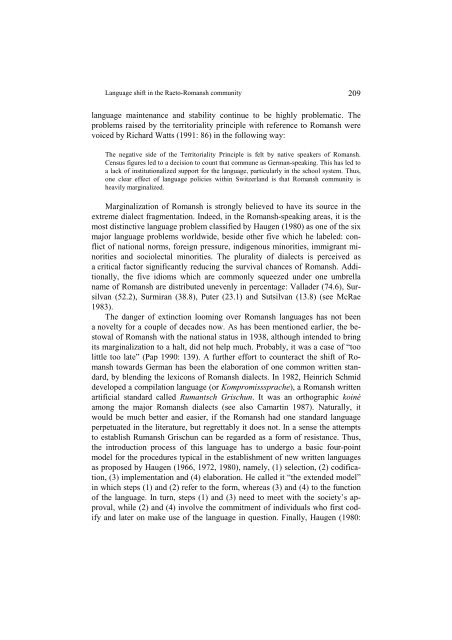s - Wyższa SzkoÅa Filologiczna we WrocÅawiu
s - Wyższa SzkoÅa Filologiczna we WrocÅawiu
s - Wyższa SzkoÅa Filologiczna we WrocÅawiu
Create successful ePaper yourself
Turn your PDF publications into a flip-book with our unique Google optimized e-Paper software.
Language shift in the Raeto-Romansh community 209<br />
language maintenance and stability continue to be highly problematic. The<br />
problems raised by the territoriality principle with reference to Romansh <strong>we</strong>re<br />
voiced by Richard Watts (1991: 86) in the following way:<br />
The negative side of the Territoriality Principle is felt by native speakers of Romansh.<br />
Census figures led to a decision to count that commune as German-speaking. This has led to<br />
a lack of institutionalized support for the language, particularly in the school system. Thus,<br />
one clear effect of language policies within Switzerland is that Romansh community is<br />
heavily marginalized.<br />
Marginalization of Romansh is strongly believed to have its source in the<br />
extreme dialect fragmentation. Indeed, in the Romansh-speaking areas, it is the<br />
most distinctive language problem classified by Haugen (1980) as one of the six<br />
major language problems worldwide, beside other five which he labeled: conflict<br />
of national norms, foreign pressure, indigenous minorities, immigrant minorities<br />
and sociolectal minorities. The plurality of dialects is perceived as<br />
a critical factor significantly reducing the survival chances of Romansh. Additionally,<br />
the five idioms which are commonly squeezed under one umbrella<br />
name of Romansh are distributed unevenly in percentage: Vallader (74.6), Sursilvan<br />
(52.2), Surmiran (38.8), Puter (23.1) and Sutsilvan (13.8) (see McRae<br />
1983).<br />
The danger of extinction looming over Romansh languages has not been<br />
a novelty for a couple of decades now. As has been mentioned earlier, the bestowal<br />
of Romansh with the national status in 1938, although intended to bring<br />
its marginalization to a halt, did not help much. Probably, it was a case of “too<br />
little too late” (Pap 1990: 139). A further effort to counteract the shift of Romansh<br />
towards German has been the elaboration of one common written standard,<br />
by blending the lexicons of Romansh dialects. In 1982, Heinrich Schmid<br />
developed a compilation language (or Kompromisssprache), a Romansh written<br />
artificial standard called Rumantsch Grischun. It was an orthographic koiné<br />
among the major Romansh dialects (see also Camartin 1987). Naturally, it<br />
would be much better and easier, if the Romansh had one standard language<br />
perpetuated in the literature, but regrettably it does not. In a sense the attempts<br />
to establish Rumansh Grischun can be regarded as a form of resistance. Thus,<br />
the introduction process of this language has to undergo a basic four-point<br />
model for the procedures typical in the establishment of new written languages<br />
as proposed by Haugen (1966, 1972, 1980), namely, (1) selection, (2) codification,<br />
(3) implementation and (4) elaboration. He called it “the extended model”<br />
in which steps (1) and (2) refer to the form, whereas (3) and (4) to the function<br />
of the language. In turn, steps (1) and (3) need to meet with the society’s approval,<br />
while (2) and (4) involve the commitment of individuals who first codify<br />
and later on make use of the language in question. Finally, Haugen (1980:
















